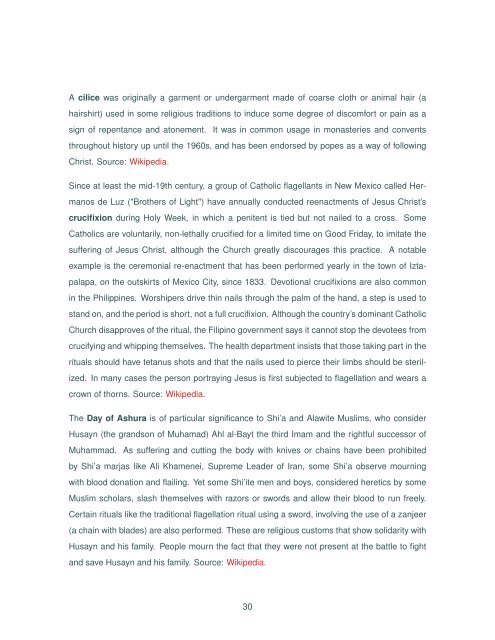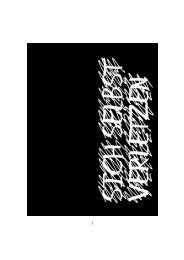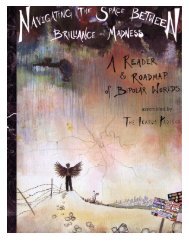You also want an ePaper? Increase the reach of your titles
YUMPU automatically turns print PDFs into web optimized ePapers that Google loves.
A cilice was originally a garment or undergarment made of coarse cloth or animal hair (a<br />
hairshirt) used in some religious traditions to induce some degree of discomfort or pain as a<br />
sign of repentance and atonement. It was in common usage in monasteries and convents<br />
throughout history up until the 1960s, and has been endorsed by popes as a way of following<br />
Christ. Source: Wikipedia.<br />
Since at least the mid-19th century, a group of Catholic flagellants in New Mexico called Her-<br />
manos de Luz ("Brothers of Light") have annually conducted reenactments of Jesus Christ’s<br />
crucifixion during Holy Week, in which a penitent is tied but not nailed to a cross. Some<br />
Catholics are voluntarily, non-lethally crucified for a limited time on Good Friday, to imitate the<br />
suffering of Jesus Christ, although the Church greatly discourages this practice. A notable<br />
example is the ceremonial re-enactment that has been performed yearly in the town of Izta-<br />
palapa, on the outskirts of Mexico City, since 1833. Devotional crucifixions are also common<br />
in the Philippines. Worshipers drive thin nails through the palm of the hand, a step is used to<br />
stand on, and the period is short, not a full crucifixion. Although the country’s dominant Catholic<br />
Church disapproves of the ritual, the Filipino government says it cannot stop the devotees from<br />
crucifying and whipping themselves. <strong>The</strong> health department insists that those taking part in the<br />
rituals should have tetanus shots and that the nails used to pierce their limbs should be steril-<br />
ized. In many cases the person portraying Jesus is first subjected to flagellation and wears a<br />
crown of thorns. Source: Wikipedia.<br />
<strong>The</strong> Day of Ashura is of particular significance to Shi’a and Alawite Muslims, who consider<br />
Husayn (the grandson of Muhamad) Ahl al-Bayt the third Imam and the rightful successor of<br />
Muhammad. As suffering and cutting the body with knives or chains have been prohibited<br />
by Shi’a marjas like Ali Khamenei, Supreme Leader of Iran, some Shi’a observe mourning<br />
with blood donation and flailing. Yet some Shi’ite men and boys, considered heretics by some<br />
Muslim scholars, slash themselves with razors or swords and allow their blood to run freely.<br />
Certain rituals like the traditional flagellation ritual using a sword, involving the use of a zanjeer<br />
(a chain with blades) are also performed. <strong>The</strong>se are religious customs that show solidarity with<br />
Husayn and his family. People mourn the fact that they were not present at the battle to fight<br />
and save Husayn and his family. Source: Wikipedia.<br />
30




